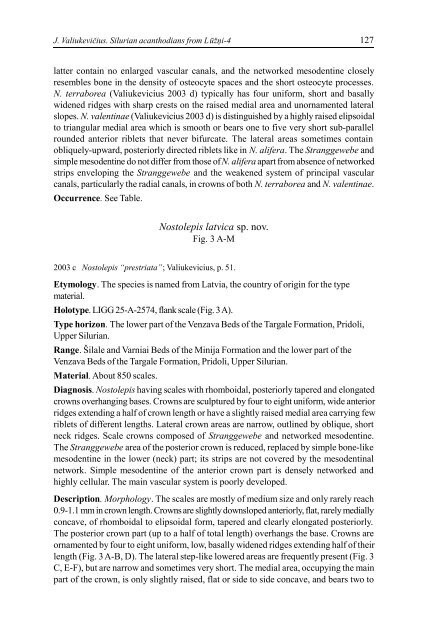Zemes un vides zinātnes Earth and Environment Sciences - Latvijas ...
Zemes un vides zinātnes Earth and Environment Sciences - Latvijas ...
Zemes un vides zinātnes Earth and Environment Sciences - Latvijas ...
Create successful ePaper yourself
Turn your PDF publications into a flip-book with our unique Google optimized e-Paper software.
J. Valiukevičius. Silurian acanthodians from Lūžņi-4<br />
127<br />
latter contain no enlarged vascular canals, <strong>and</strong> the networked mesodentine closely<br />
resembles bone in the density of osteocyte spaces <strong>and</strong> the short osteocyte processes.<br />
N. terraborea (Valiukevicius 2003 d) typically has four <strong>un</strong>iform, short <strong>and</strong> basally<br />
widened ridges with sharp crests on the raised medial area <strong>and</strong> <strong>un</strong>ornamented lateral<br />
slopes. N. valentinae (Valiukevicius 2003 d) is distinguished by a highly raised elipsoidal<br />
to triangular medial area which is smooth or bears one to five very short sub-parallel<br />
ro<strong>un</strong>ded anterior riblets that never bifurcate. The lateral areas sometimes contain<br />
obliquely-upward, posteriorly directed riblets like in N. alifera. The Stranggewebe <strong>and</strong><br />
simple mesodentine do not differ from those of N. alifera apart from absence of networked<br />
strips enveloping the Stranggewebe <strong>and</strong> the weakened system of principal vascular<br />
canals, particularly the radial canals, in crowns of both N. terraborea <strong>and</strong> N. valentinae.<br />
Occurrence. See Table.<br />
Nostolepis latvica sp. nov.<br />
Fig. 3 A-M<br />
2003 c Nostolepis “prestriata”; Valiukevicius, p. 51.<br />
Etymology. The species is named from Latvia, the co<strong>un</strong>try of origin for the type<br />
material.<br />
Holotype. LIGG 25-A-2574, flank scale (Fig. 3 A).<br />
Type horizon. The lower part of the Venzava Beds of the Targale Formation, Pridoli,<br />
Upper Silurian.<br />
Range. Šilale <strong>and</strong> Varniai Beds of the Minija Formation <strong>and</strong> the lower part of the<br />
Venzava Beds of the Targale Formation, Pridoli, Upper Silurian.<br />
Material. About 850 scales.<br />
Diagnosis. Nostolepis having scales with rhomboidal, posteriorly tapered <strong>and</strong> elongated<br />
crowns overhanging bases. Crowns are sculptured by four to eight <strong>un</strong>iform, wide anterior<br />
ridges extending a half of crown length or have a slightly raised medial area carrying few<br />
riblets of different lengths. Lateral crown areas are narrow, outlined by oblique, short<br />
neck ridges. Scale crowns composed of Stranggewebe <strong>and</strong> networked mesodentine.<br />
The Stranggewebe area of the posterior crown is reduced, replaced by simple bone-like<br />
mesodentine in the lower (neck) part; its strips are not covered by the mesodentinal<br />
network. Simple mesodentine of the anterior crown part is densely networked <strong>and</strong><br />
highly cellular. The main vascular system is poorly developed.<br />
Description. Morphology. The scales are mostly of medium size <strong>and</strong> only rarely reach<br />
0.9-1.1 mm in crown length. Crowns are slightly downsloped anteriorly, flat, rarely medially<br />
concave, of rhomboidal to elipsoidal form, tapered <strong>and</strong> clearly elongated posteriorly.<br />
The posterior crown part (up to a half of total length) overhangs the base. Crowns are<br />
ornamented by four to eight <strong>un</strong>iform, low, basally widened ridges extending half of their<br />
length (Fig. 3 A-B, D). The lateral step-like lowered areas are frequently present (Fig. 3<br />
C, E-F), but are narrow <strong>and</strong> sometimes very short. The medial area, occupying the main<br />
part of the crown, is only slightly raised, flat or side to side concave, <strong>and</strong> bears two to
















